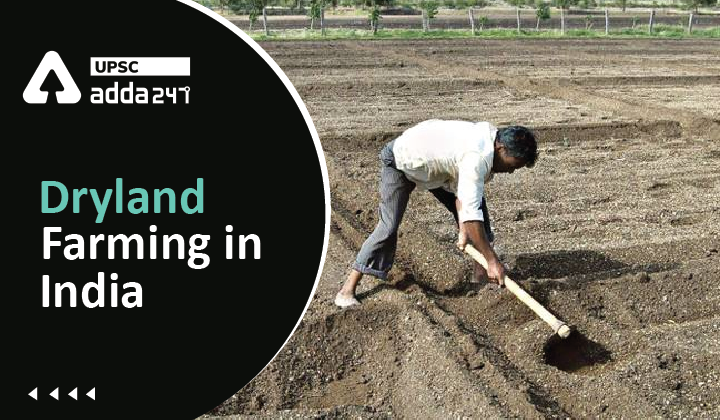Table of Contents
What is dryland farming?
- Dryland refers to an area where annual rainfall is between 750 mm and 1150mm. Due to this reason, farming in these areas need an improved system of cultivation whereby maximum amount of soil and water is conserved. It is called dry land farming.
Understanding the difference
| Type of farming | Rainfall |
| Dry farming | <750mm |
| Dryland farming | 750mm-1150mm |
| Rainfed farming | >1150mm |
Characteristics of dryland farming
- Annual rainfall in these regions is uncertain, ill-distributed and limited.
- There is an occurrence of extensive climatic hazards like drought, flood etc in these regions.
- The soil surface in these regions is also undulating;
- In these regions, farmers have extensive and large land holdings;
- In these areas, farmers practice extensive agriculturee., prevalence of mono cropping etc;
- Farmers in these regions grow similar type of crops.
- These crops in these regions have very low crop yield.
Dryland farming in India
- Major dry farming crops are millets such as jowar, bajra, ragi; oilseeds like mustard, rapeseed and pulse crops like pigeon pea, gram and lentils.
- In India, almost 80 percent of maize, 90 percent of Bajra, approximately 95 percent of pulses and 75 percent of oilseeds are obtained from dryland agriculture.
Dryland farming in India: Measures to be taken
- Need to grow those crops which are drought tolerant.
- These regions often face the situation of soil erosion. So, management of such areas can be achieved by stabilizing the soils by forestry and pasture, with regulated grazing.
- India’s protein security is mostly depending on the dry land farming, so there is a need to adapt technologies from the countries like Israel, which has a significant experience and expertise in dry land farming.
- Agronomic measures: proper tillage, proper management of the time of sowing, fertilizer management, selection of proper cropping systems suitable to the area like double cropping, alley cropping, use of better cropping pattern for specific locations, proper weed control and plant protection measures.
Dryland farming: Success stories
- Ralegaon siddhi ,
- Hivere bajar in Maharashtra and
- Sukhomajari in Haryana is e.g., of success of dry land.
Dryland farming: Government initiatives
- The National Mission for Sustainable Agriculture (NMSA), which is one of the eight missions under the National Action Plan on Climate Change (NAPCC) seeks to address issues associated with climate change.
- Sub-Mission on Agroforestry under the framework of National Mission for Sustainable Agriculture (NMSA) has been launched during 2016-17 for a period of 4 years (2016-17 to 2019-20).
- National Agroforestry Policy, 2014 has been formulated to bring coordination, convergence and synergy between various elements of agroforestry that are scattered in various existing Missions, programmes and schemes of the Government.
- Pradhan Mantri Krishi Sinchayee Yojana (PMKSY) was launched on 1st July, 2015 with the motto of ‘Har Khet Ko Paani’ for providing end-to end solutions in irrigation supply chain, viz. water sources, distribution network and farm level applications.
- Agriculture Contingency Plan: CRIDA, ICAR has prepared district level Agriculture Contingency Plans in collaboration with state agricultural universities to tackle aberrant monsoon situations leading to drought and floods, extreme events adversely affecting crops, livestock and fisheries.
- Government of India has declared 2018 as year of millets to encourage dryland crops like millets.
Read UPSC favourite topics





 TSPSC Group 1 Question Paper 2024, Downl...
TSPSC Group 1 Question Paper 2024, Downl...
 TSPSC Group 1 Answer key 2024 Out, Downl...
TSPSC Group 1 Answer key 2024 Out, Downl...
 UPSC Prelims 2024 Question Paper, Downlo...
UPSC Prelims 2024 Question Paper, Downlo...





